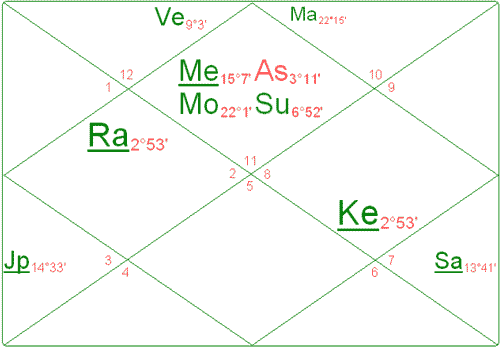Spring | Summer | Fall | Winter | |
2025 | Volume 67 |
| Volume 65 | Volume 66 |
Volume 10, 21 September 2010
“Autumn is the mellower season, and what we lose in flowers we more than gain in fruits.”
The Autumn Sky Show
Our autumnal equinox this year comes with a gorgeous viewing opportunity. I am actually sending this newsletter out ahead of the exact equinox so you can have an inspired start to the season. September 22nd at 11:09 PM Eastern Daylight time is the actual equinox but starting around two hours after sunset, you will see a fully retrograde Jupiter (almost exactly 180 degrees from the Sun) and a full Moon! When the Moon is full in Pisces and aspected by (or conjoined with) a friendly graha, we get a Raja Yoga so it is an auspicious start to the season. Hopefully it will compensate for some of the other more difficult combinations.
Sunrise on the 23rd should be spectacular starting with elusive Mercury rising pre- dawn followed by the rising Sun in the East opposite a full Moon and Jupiter still tightly together setting in the West. Although sunset that day will also be spectacular, the Moon will have moved out of its close proximity to Jupiter.
A nice way to continue your star gazing is to look for the nights when Jupiter and the Moon are similarly conjoined. In addition to the dates mentioned above, October 19th has Jupiter and the Moon very close together in the southeastern sky in the same viewing timeframe. Jupiter will be positioned just below and to the left of the Moon. November 15th will afford another view of a very similar grouping.
The drama of the seasonal changes continues this winter. Coincidentally, we have a major event occurring right on the winter solstice. Just in case you don’t get that newsletter in time, we have a full lunar eclipse that will be visible in the Northern Hemisphere starting at 12:27 AM on the 21st with the greatest eclipse at 3:17 AM. Please note that in the Vedic tradition, viewing a lunar eclipse let alone a total eclipse, is not considered an auspicious thing to do though it is quite a compelling event. There are a number of suggested ways to spend your time during such an eclipse. Let me know if you are interested in hearing about them.
Dharma and the Astrological Chart
Last newsletter I introduced the concept of purusharthas along with some preliminary information about how they connect to the astrological chart.
Since the purushartha known as dharma is the one that separates man as the conscious being who has the choice to uphold or violate natural law, it is very useful to be able to assess to what extent a person naturally leans in either direction as viewed through the lens of Jyotisha.
As usual, the context of a chart is much more important than particular combinations so I ask my readers not to draw any conclusions about their own destiny patterns from some of the following broad stroke ideas and examples. They are meant to stimulate thought and discussion rather than be rigid principles of interpretation.
A person whose birth chart shows a web of connections between the dharma houses and the owners of those dharma houses will be someone whose life emphasizes (for better or worse) this idea of alignment to universal values. What are the dharma houses? They are the first, fifth and ninth houses or bhavas of the horoscope. It is said in the tradition that these are the sthanas or places of Goddess Lakshmi who dispenses grace and good fortune. They indicate purva punya - merit from the past being brought into this lifetime. They also show the ability to acquire merit in this lifetime.
The constellations or rashis of Aries, Leo and Sagittarius are designated as the fire element. Fire is linked to the purushartha of dharma. Therefore when someone is born with a fire sign rising, the other two fire signs will also fall on the dharma houses (five and nine). One could say then that those ascendants have a built in propensity towards dharma or adharma. However, as always, the context of the chart is critical.
A Jyotishi will also look at the planet Jupiter whose significations include dharma and upholding the natural order of things. When Jupiter is in a dharma house, it will aspect the other two dharma houses and so becomes a powerful marker for aligning to this purushartha.
Dharma is not as simple an idea as our common Western notion that dharma is our job would suggest. Libraries could be filled with treatises discussing different aspects of dharma and its role in the evolution of a person towards full maturity.
For our purposes, in addition to the idea of grace or purva punya, we can also think of people with strong dharma combinations as those who plan and strategize well. They are interested in knowing who they are and understanding themselves and others largely through the lens of philosophy, psychology, education, religion and the arts. They tend to gravitate to causes and groups that they perceive as upholding universal values. However, they can get hugely detoured by false prophets or they themselves can be charismatic charlatans if the dharma lords are poorly disposed.

Here is a classic example chart for seeing dharma in a horoscope. It belongs to the celebrated saint and teacher Ramakrishna Paramahamsa. We see that Saturn, the lord of the ascendant for this Aquarius rising sign, has gone to the ninth bhava. He therefore has the lord of a dharma house in a dharma house. This is an important feature in any chart but in this chart, Saturn (the first lord) has the distinction of being exalted in the ninth bhava and it is rendered doubly powerful by also being retrograde.
In addition, Mercury who owns the fifth house (dharma house) is located in the first where it is very strong by having directional strength (dig bala).
To underscore the extent to which dharma is highlighted in this brilliant example, Jupiter representing dharma is itself in the fifth and therefore aspecting the first and the ninth. This Jupiter is likewise powerful through retrogression. This entire chart if read from the Moon (Chandra lagna) or the Sun (Surya lagna) would be exactly the same which is a huge confirmation of what is seen by reading the chart from the rising sign itself. There is perfect alignment of the three viewpoints “sealing the deal”.
In addition, all three dharma lords are powerful. Saturn owning the ascendant is exalted and retrograde with no affliction or weakness. Mercury owning the first has directional strength and no weakness while being stabilized by Jupiter. Venus who owns the ninth is also exalted with no weakness or affliction.
Ramakrishna is a celebrated luminary in the Vedic tradition creating an inspired lineage of great teachers who have spread the teaching of dharma worldwide. His chart and life are beautiful example s of the unfoldment of the purushartha of dharma.
The Media Corner
Portraits of a Nation: History of Ancient India
By Kamlesh Kapur
Recent advances in the diverse fields of genetics, DNA evidence, archeology and natural history have pointed to the need for an authentic account of India’s past that would be free of outside cultural bias. This book is an attempt to do away with errors, inconsistencies and undocumented accounts of the origins of and contributions to Indian civilization and culture. These errors are ubiquitous in books and teaching materials worldwide.
Ms. Kapur is above all an educator with a long commitment to the concepts of multiculturalism and diversity. She taught World and Global history for over twenty years to secondary school students and is all too familiar with the problems in how Indian history is handled in contemporary texts.
The History of Ancient India is presented as a series of lessons geared towards high school students and therein is its great strength. The material is organized in very digestible units complete with maps, diagrams and annotated points from the current research. She raises questions, suggests enrichment activities and summarizes the main points of each section for greater clarity.
Those who love the Vedic tradition will find this a fascinating and rich presentation of the many accounts of Ancient India. It is a valuable resource for the latest research on Indian antiquity and a strong stimulus to follow how India will reclaim what is her own heritage.












